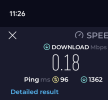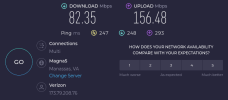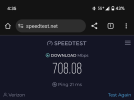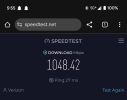3.71Mbps isn't dial up lol
Navigation
Install the app
How to install the app on iOS
Follow along with the video below to see how to install our site as a web app on your home screen.
Note: This feature may not be available in some browsers.
More options
You are using an out of date browser. It may not display this or other websites correctly.
You should upgrade or use an alternative browser.
You should upgrade or use an alternative browser.
Test Your Internet Speed.
- Thread starter iluvmycsx
- Start date
- Staff
- #765
- 57,156
- 24,332
Found booty

You live in NoVa area?
Interesting your upload is almost double your download speeds.

Edit: The latency..

Yep, I'm from NoVa. Depends on the time of the day and the number of users in the network. Right now, though, things seem pretty balanced.You live in NoVa area?
Interesting your upload is almost double your download speeds.
Edit: The latency..
- Staff
- #772
- 10,415
- 7,063
- Vehicle Model
- Toyota Tacoma TRD Sport
- Body Style
- @bootyluvr hates hatches
Seriously......50G? Whaaaaaaaaaaaaaaaaaaaaa
Ziply Fiber introduced a 50 Gbit/s broadband service across its entire fiber network in Washington, Oregon, Idaho and Montana. But Ziply Fiber's top-shelf speed offering, which sells for a lofty $900 per month, doesn't use PON. Instead it's underpinned by a fiber-based Ethernet connection that requires some additional, specialized equipment in the customer's home.
Türk Telekom and ZTE have also connected on a 50G PON trial.
'The new norm'
GFiber currently offers symmetrical 8 Gbit/s speeds in all its fiber markets (with XGS-PON), and up to 20 Gbit/s in select markets, including Kansas City, North Carolina's Triangle region, and parts of Arizona and Iowa. More GFiber markets will get access to 20-Gig speeds as the operator looks to deploy Nokia's 25G PON technology across all its markets by the end of the year.
Multi-gig speeds are "already the new norm," Hsu explained, adding that the new 50G PON technology will be able to coexist with the fiber running the operator's XGS-PON and 25G PON infrastructure. In the Kansas City trial, GFiber said it used Nokia gear to simultaneously run 10G/25G PON along with 25G/50G PON over its fiber network.
https://www.lightreading.com/fttx/google-fiber-and-nokia-take-50g-pon-for-a-spin
Ziply Fiber introduced a 50 Gbit/s broadband service across its entire fiber network in Washington, Oregon, Idaho and Montana. But Ziply Fiber's top-shelf speed offering, which sells for a lofty $900 per month, doesn't use PON. Instead it's underpinned by a fiber-based Ethernet connection that requires some additional, specialized equipment in the customer's home.
Türk Telekom and ZTE have also connected on a 50G PON trial.
'The new norm'
GFiber currently offers symmetrical 8 Gbit/s speeds in all its fiber markets (with XGS-PON), and up to 20 Gbit/s in select markets, including Kansas City, North Carolina's Triangle region, and parts of Arizona and Iowa. More GFiber markets will get access to 20-Gig speeds as the operator looks to deploy Nokia's 25G PON technology across all its markets by the end of the year.
Multi-gig speeds are "already the new norm," Hsu explained, adding that the new 50G PON technology will be able to coexist with the fiber running the operator's XGS-PON and 25G PON infrastructure. In the Kansas City trial, GFiber said it used Nokia gear to simultaneously run 10G/25G PON along with 25G/50G PON over its fiber network.
https://www.lightreading.com/fttx/google-fiber-and-nokia-take-50g-pon-for-a-spin
- Staff
- #773
- 57,156
- 24,332
you're getting into big boy commercial type speeds that require some serious hardware. The router they recommend to run that plan runs around $2300 if that gives you an idea.Seriously......50G?
View: https://youtu.be/7_uLxZYYEpQ
Amazon product ASIN B0B6QCWNL3View: https://www.amazon.com/Mikrotik-CCR2216-1G-12XS-2XQ-Gigabit-Ethernet-RouterOS/dp/B0B6QCWNL3
- Staff
- #774
- 10,415
- 7,063
- Vehicle Model
- Toyota Tacoma TRD Sport
- Body Style
- @bootyluvr hates hatches
What's the point of it and who actually uses it?
- Staff
- #775
- 57,156
- 24,332
big gamers, streamers, day traders, remote work in editing, media etc could potentially justify it if you're moving large files constantly. Say you wanted to work from home and you work had huge files you had to work with... you could in theory pull those files to your home insanely fast (as long as your work server could handle the transfer/upload fast). I would assume the upload speed is also really high to transfer files back to work or whatever.
- Staff
- #777
- 57,156
- 24,332
That’s about 1047 more than me
Janz3n
Well-Known Member
I still don't have 5g.
Janz3n
Well-Known Member
we have 5g, my provider just doesnt offer it. i cant think of a reason i would need it anyways.Because Canada

